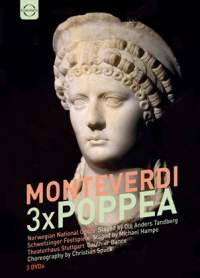Texte paru dans: / Appeared in: |
|
|
Outil de traduction (Très approximatif) |
|
|
Reviewer: David Vickers L’incoronazione di Poppea has always been the subject of revisionist fascination. The first modern performance, directed by Vincent d’Indy at the Schola Cantorum in Paris in 1905, was sung in French, and the heavily cut music was extensively recomposed – d’Indy proclaimed that ‘it has been my intention to produce a work of art, not of archaeology’. This kind of attitude to creativity has prevailed in plenty of interventionist reinventions of Poppea, three of which are contained within EuroArts’ triple-whammy DVD collection. René Jacobs’s liberal composition of an orchestral ‘realisation’ is intrusive tinkering on a par with Leppard and Harnoncourt before him but Michael Hampe’s sparse staging (Schwetzingen, 1993) is an intelligently taut drama that delineates the plot and characters with admirable clarity. Set atop a globe of the world, simple props are used sparingly and to concentrated effect (the knife presented to Harry Peeters’s dignified Seneca and a throne and crown crop up as required). Nerone is transposed down an octave for tenor Richard Croft, whose performance is imperious, ardent and devious; the clash between the selfish emperor and his philosophical tutor’s unwelcome wise counsel has vivid confrontational tension. Patricia Schuman’s manipulative Poppea, Kathleen Kuhlmann’s icy Ottavia and Darla Brook’s courageous Drusilla are all a good fit for their characters; only Jeffrey Gall’s pallid Ottone is underwhelming. Alessandro de Marchi uses similar techniques to Jacobs for Norwegian National Opera (2010) but, apart from a couple of dashes of percussion-adorned flamenco and one particularly kitsch mutation into cocktail-lounge jazziness, he tends to let continuo-based accompaniments speak more naturally for themselves. Ole Anders Tandberg’s gratuitous production is filmed by Anja Stabell and Stein-Roger Bull in monochrome with splashes of red (such as lips and truckloads of blood), and the initially gorgeous stylisation becomes repulsively degenerate from Seneca’s suicide onwards. Act 3 is subverted into a chain of gory murders and suicides that leaves the stage strewn with the bodies of almost every character except Nerone and Poppea, whose final duet is a frenzied orgy in the blood of their victims. The production is fundamentally risible, although I admired Tim Mead’s nuanced Ottone, Patricia Bardon’s deranged Ottavia and Marita Sølberg’s complex Drusilla. The Gauthier Dance Company (Stuttgart’s Theaterhaus, 2013) convey a unique vision of how the plot of an opera can inspire dramatic reinvention but with barely a note of the problematic score being heard. An MC gives a spoken introduction to the main characters and events of the story, and thereafter the dancers explore the emotional and psychological tangents of the characters’ motivations on a symbolic level (although a linear treatment of the plot emerges towards the end). Dressed almost entirely in black and dancing in a simple studio setting with only a few props, the dancers scream in unison from time to time, the MC repeats or mimes fragments of her introduction sporadically and at times Christian Spuck’s extraordinary choreography strays awkwardly close to a satirical send-up of interpretative dance. Sound installation artist Martin Donner is the unseen DJ, whose soundtrack is a mash-up of Schumann, Icelandic pop star Emilíana Torrini, American singersongwriter Cat Power and Geminiani’s orchestration of Corelli’s variations on La folia; Monteverdi is represented via fragmentary, scratched and remixed ambient treatments of different works: the duet from Tirsi e Clori illustrates the seductive Poppea’s dancing with the infatuated Nerone; ‘Si dolce è ’l tormento’ provides an unexpectedly profound portrayal of Ottavia’s shameful exile. It is difficult to watch the most neurotic convolutions with a straight face, but the creative reinvention of an opera with barely any of its actual music or libretto until the final scene (a remix of ‘Pur ti miro’) testifies to the enduring fascination artists have for Monteverdi’s last opera. |
|




